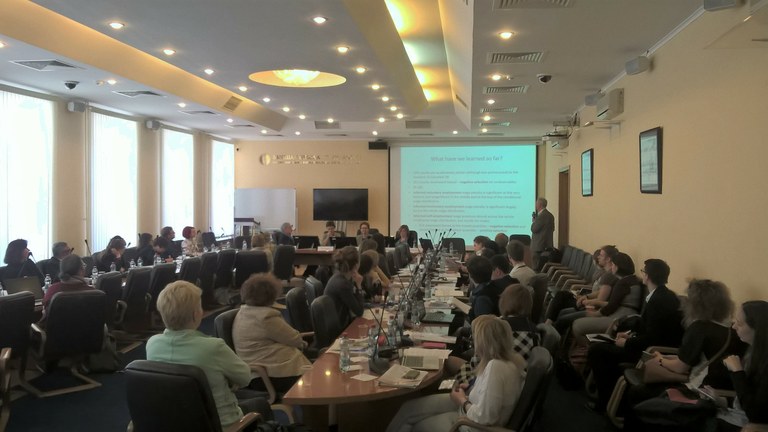Russia Longitudinal Monitoring Survey of HSE
The Russia Longitudinal Monitoring Survey (RLMS) is a series of nationally representative surveys designed to monitor the effects of Russian reforms on the health and economic welfare of households and individuals in the Russian Federation. These effects are measured by a variety of means: detailed monitoring of individuals' health status and dietary intake, precise measurement of household-level expenditures and service utilization, and collection of relevant community-level data, including region-specific prices and community infrastructure data. Phase II data have been collected annually (with two exceptions) since 1994. The project has been run jointly by the Carolina Population Center at the University of North Carolina at Chapel Hill, started by Barry M. Popkin and now headed by Klara Peter, and the Demoscope team in Russia, headed by Polina Kozyreva and Mikhail Kosolapov.
The history of the RLMS, the sample design and replenishment sample designs, and the loss-to-follow up and other key factors are provided in the data resource profile published by the International Journal of Epidemiology in 2016. 1
5th International RLMS Users Conference, Moscow, May 28-29, 2021 (Click here for details)
The conference aims to provide a forum for the discussion of the research projects based on the Russia Longitudinal Monitoring Survey of HSE. Researchers from all disciplines (e.g. economics, demography, sociology, political sciences, public health, and psychology) who use RLMS-HSE are invited to submit their papers or extended abstracts. Priority will be given to the papers that make use of the longitudinal features of the data and/or provide cross-national comparisons.
Submission: For full consideration, proposals must be submitted to rlmshse2021@gmail.com by February 1, 2021. Notices of acceptance will be sent to the researchers by March 1, 2021.
Longitudinal Files covering 1994-2019 are Now Available!
Demoscope and the HSE have prepared longitudinal files containing all years of data from 1994-2019, both for the individual data (adults and children) and for the household data. Each observation is an individual or a household with all variables available for that year. The variable values have been standardized across years. Individual and household identifiers are available on each observation so that researchers can examine changes over time.
In addition, the files contain both variable and value labels in English. These longitudinal files are the only files with English value labels - we have not added them to the cross-sectional files and do not plan to do so at this time. Longitudinal files are cleaned and harmonized.
Please see the CPC Data Portal to download the data: http://data.cpc.unc.edu/
Attention, please! The cross-sectional files will not be updated in 2017, the cross-sectional files for other years will be removed from CPC Dataverse in about a year.
Questionnaires Update
We've adjusted all RLMS-HSE questionnaires in English to longitudinal data files (for waves from 5 to 28). Now it is easy to find any variable using only its name.
Please see the CPC Data Portal to download the data: http://www.cpc.unc.edu/projects/rlms-hse/data/questionnaires
Longitudinal Files covering 1994-2015 were updated!
Demoscope and the HSE have updated longitudinal files containing all years of data from 1994-2015, both for the individual data (adults and children) and for the household data. The longitudinal data and new codebooks for longitudinal files are now available on CPC Dataverse.
We also updated identifiers for SPSS cross-sectional data and codes are available on CPC Dataverse. The update was made for some inconsistencies in IDIND, IDs, in dates of birth, education variables, professional and occupational codes, variables about pension and work experience for all 24 rounds. Also some variables about chronic diseases (M20.61 etc) and about physical activities (M114) were checked and corrected.
Attention, please! The cross-sectional files will be removed from CPC Dataverse in about a year.
3rd International RLMS Users Conference, Moscow, May 19-20, 2017 (Click here for details)

Dear colleagues,
It was a pleasure to meet you at the 3rd RLMS-HSE User Conference. The RLMS-HSE team wants to thank you for attending the conference. We believe that our primary goal to bring together researchers of various academic backgrounds to explore and discuss the RLMS-HSE data was successfully achieved. We found all the papers, presented at the conference, genuinely interesting and thought-provoking.
We hope you enjoyed the 3rd RLMS-HSE User Conference as much as we did. We do hope you will continue to make use of RLMS-HSE data and look forward seeing you at our future events.
Public data use NO LONGER REQUIRES AN APPLICATION.
The Individual, Household, and Community data are now available to download directly from the CPC Dataverse hosted by the Odum Institute.
The data have been reorganized and improved. We hope that researchers will find the new files easier to use. Please look here for details.
All current and future users should read this letter, which describes major changes to the RLMS-HSE.
For any group using the RLMS-HSE data, we require in all publications (book, book chapter, refereed journal article or presentation) the following acknowledgment of the institutions that now support and manage the survey. This is the only way to ensure future funding and to allow individuals with any document we might see to be allowed further access to the RLMS-HSE for them or their institution.
Source: “Russia Longitudinal Monitoring survey, RLMS-HSE”, conducted by the National Research University Higher School of Economics and ZAO “Demoscope” together with Carolina Population Center, University of North Carolina at Chapel Hill and the Institute of Sociology RAS.
1. Kozyreva P, Kosolapov M, Popkin BM. Data Resource Profile: The Russia Longitudinal Monitoring Survey—Higher School of Economics (RLMS-HSE) Phase II: Monitoring the Economic and Health Situation in Russia, 1994–2013. International Journal of Epidemiology. 2016. 10.1093/ije/dyv357 [Download PDF]


